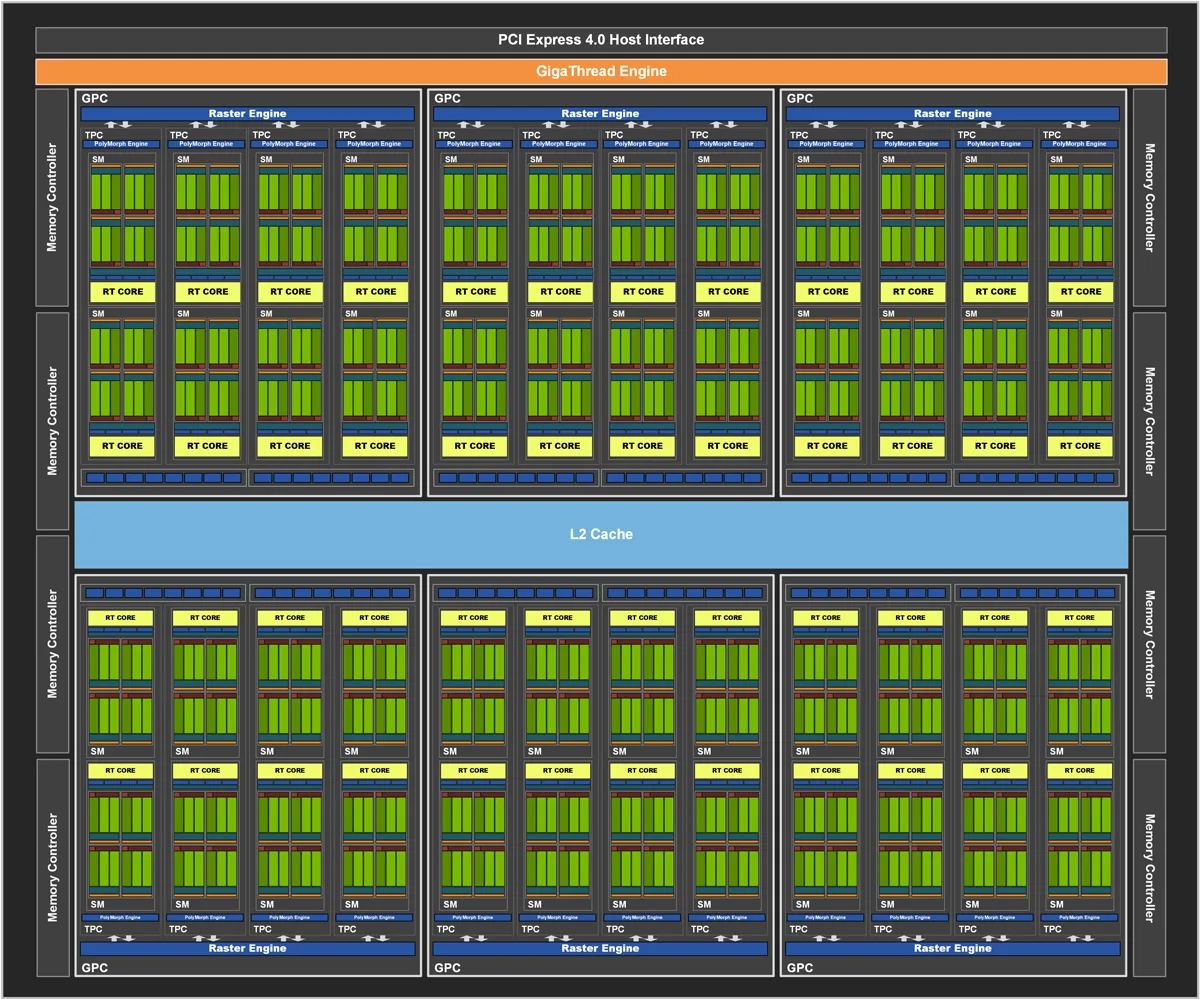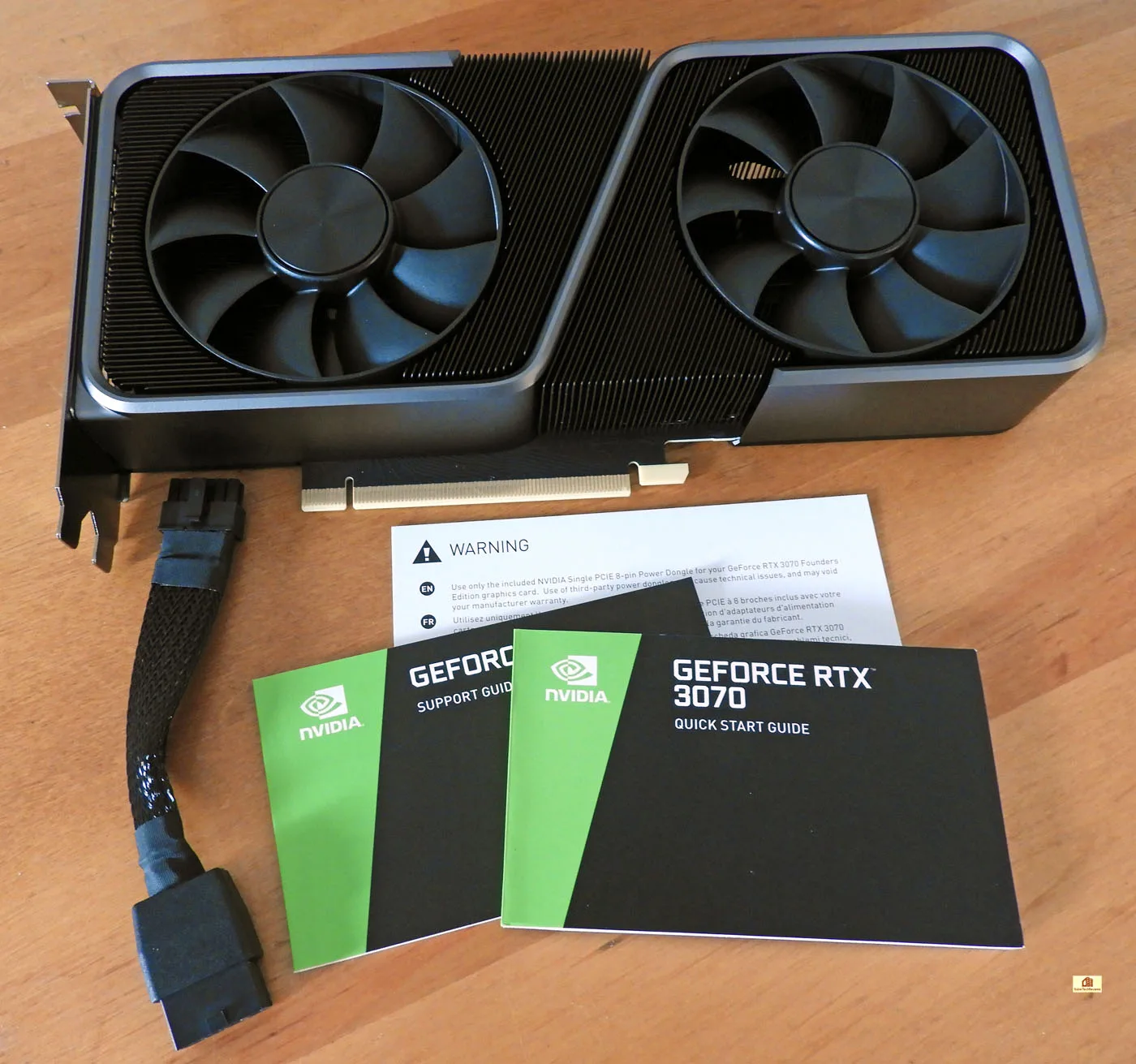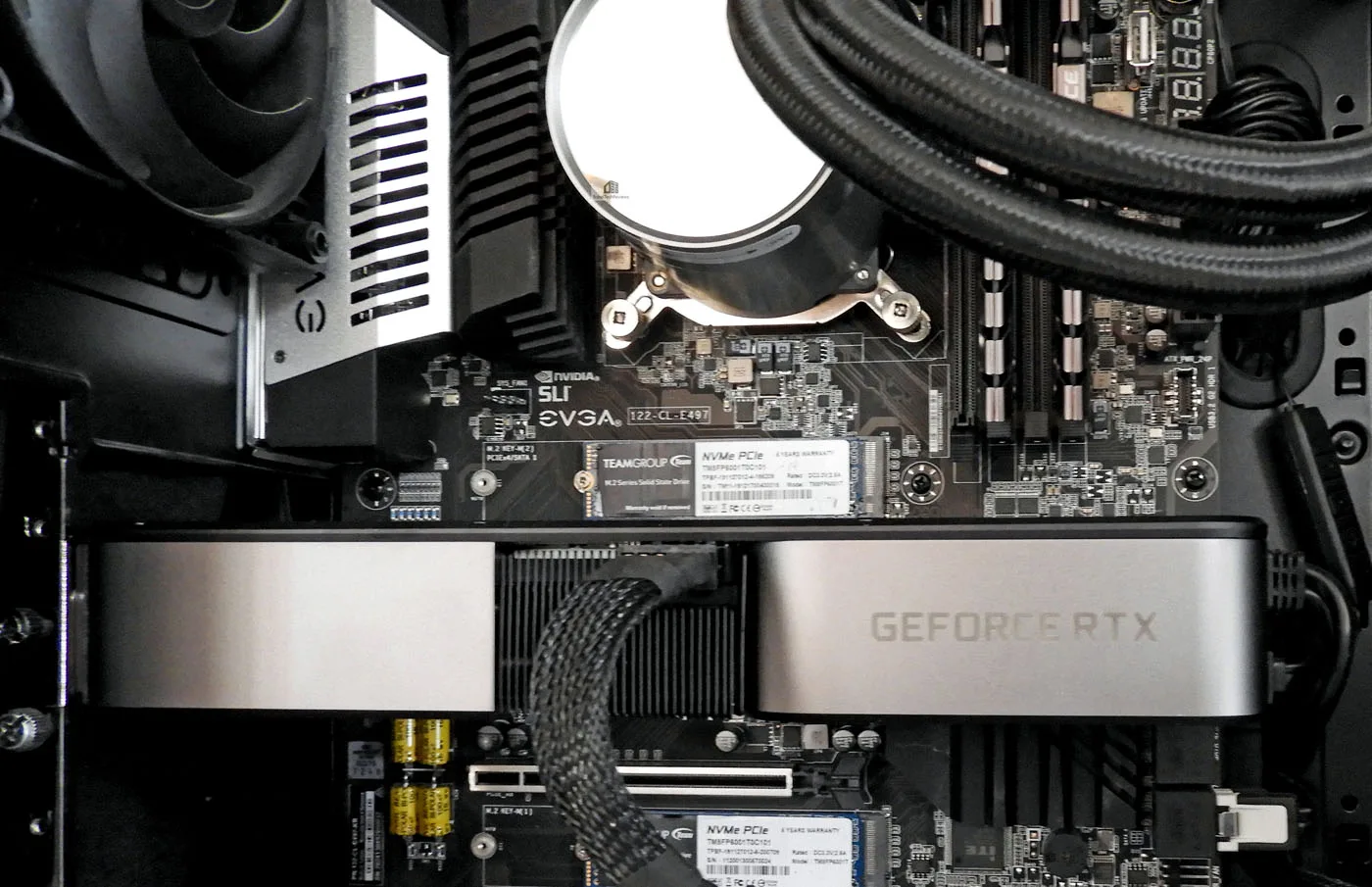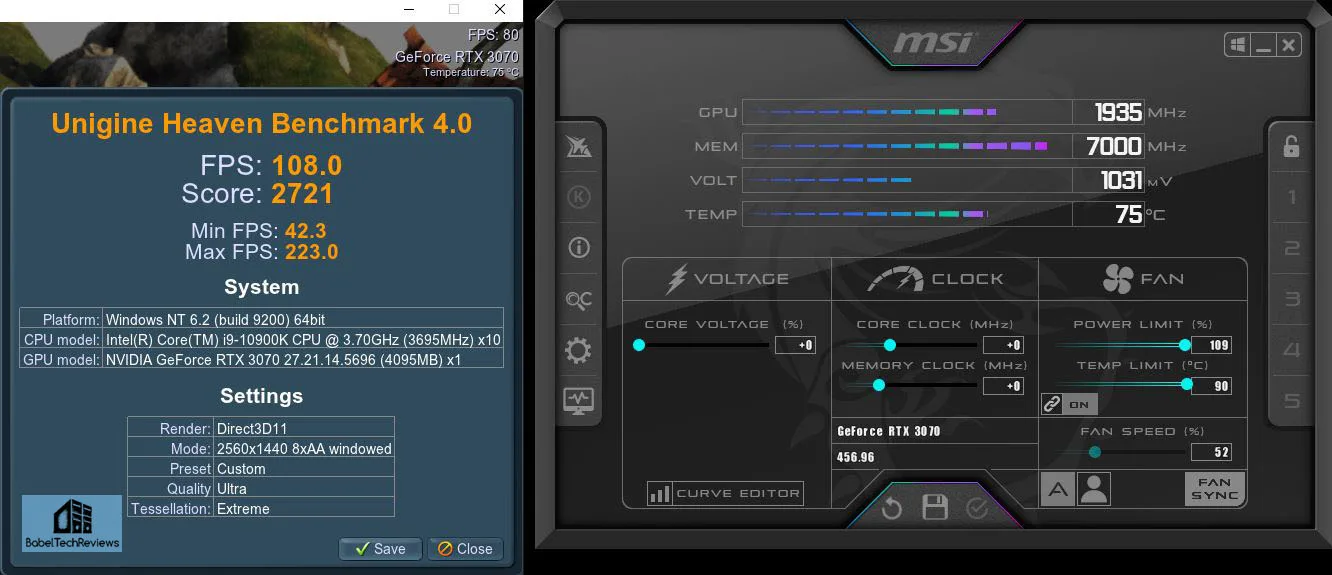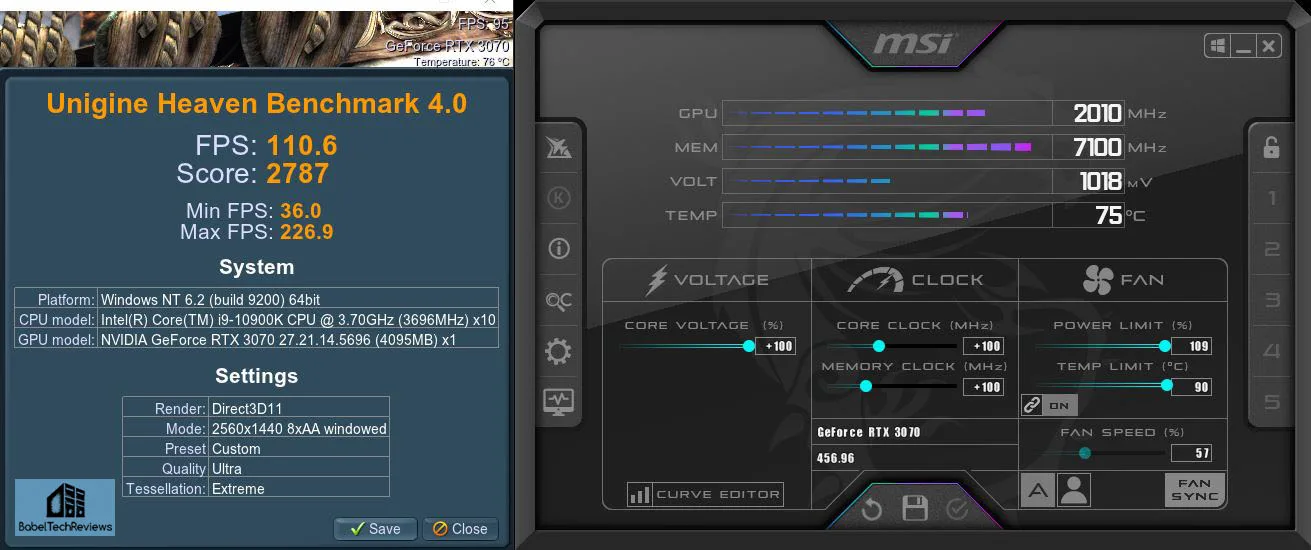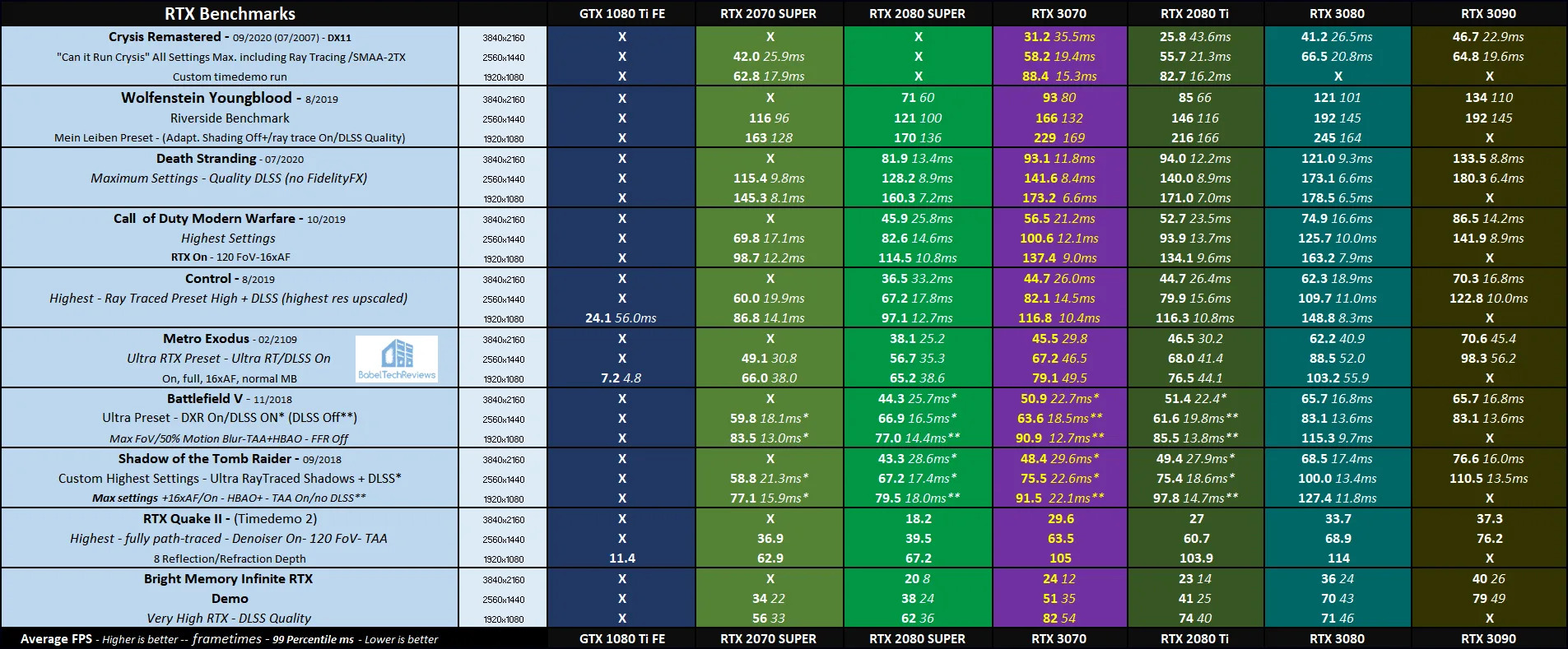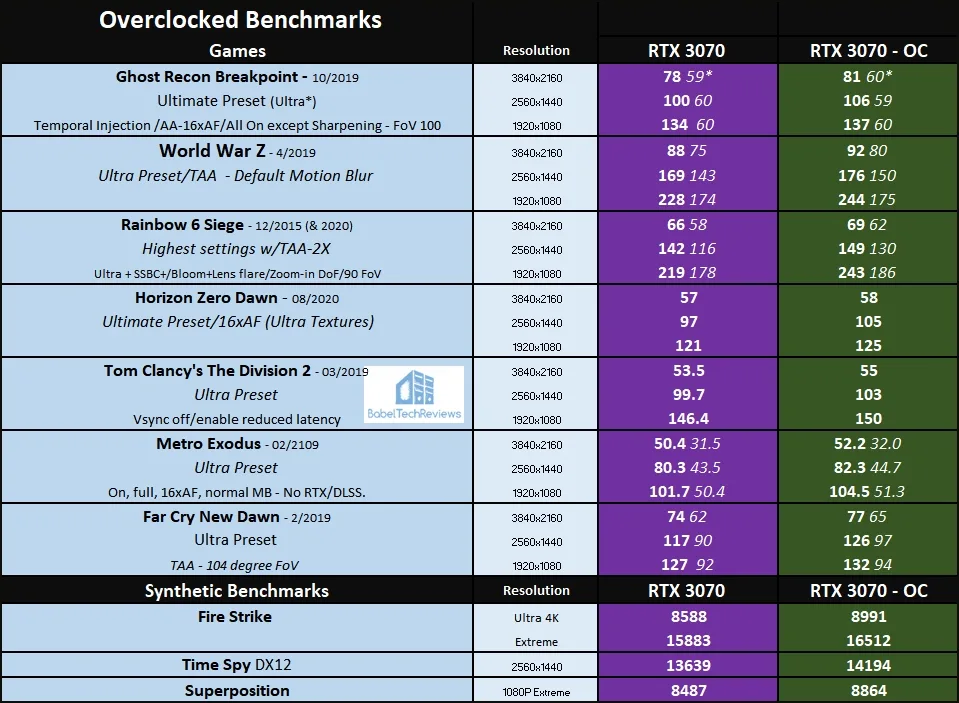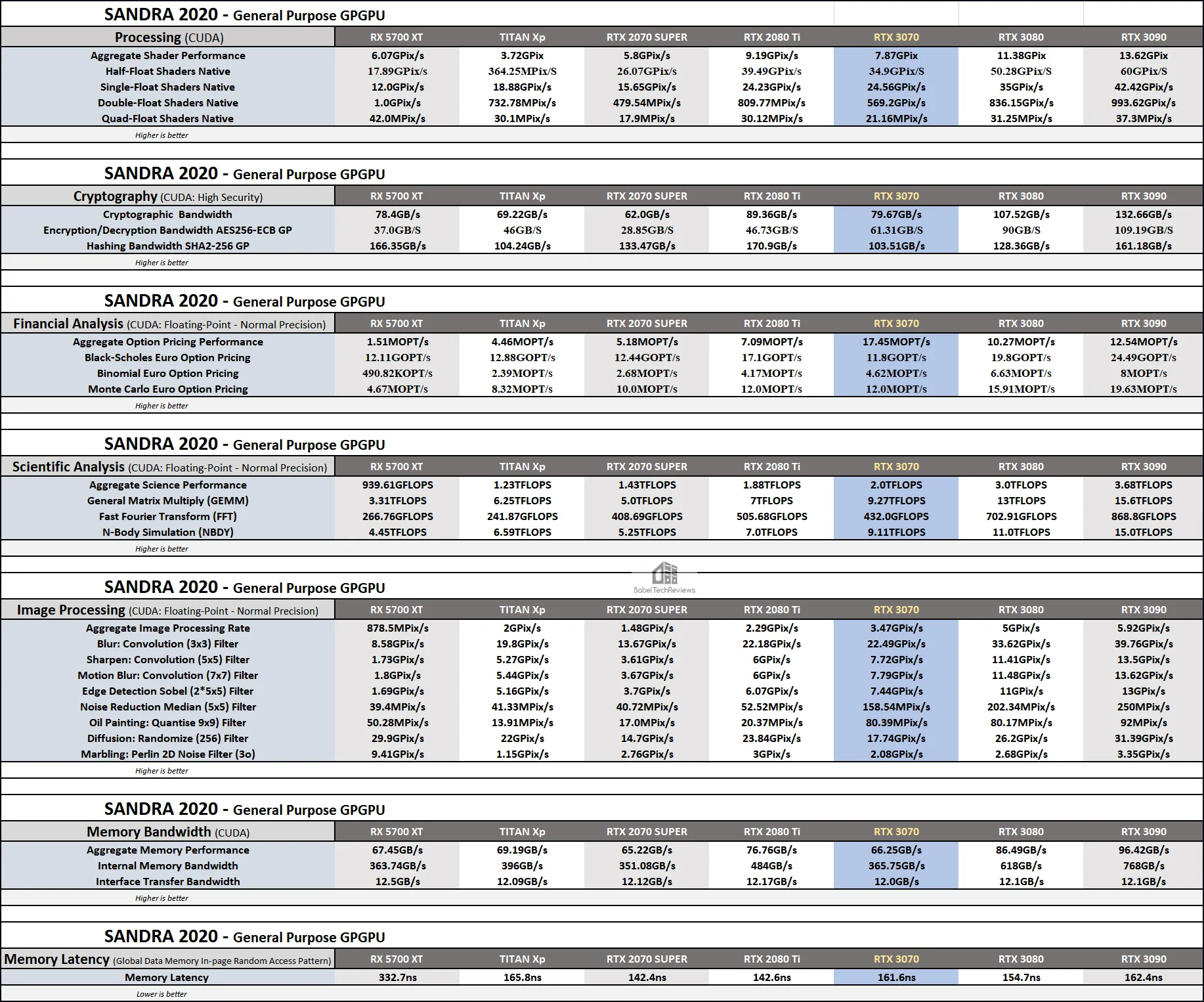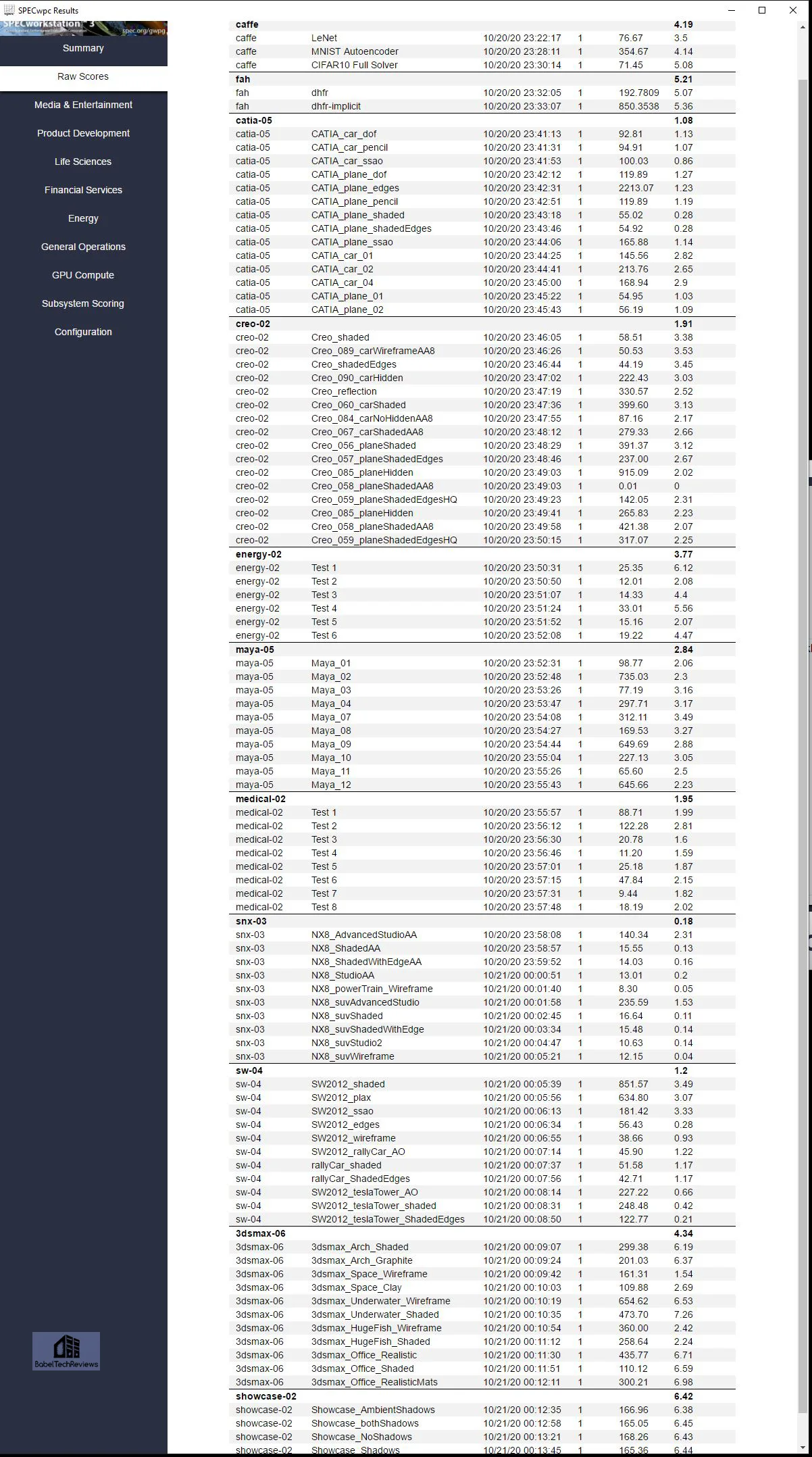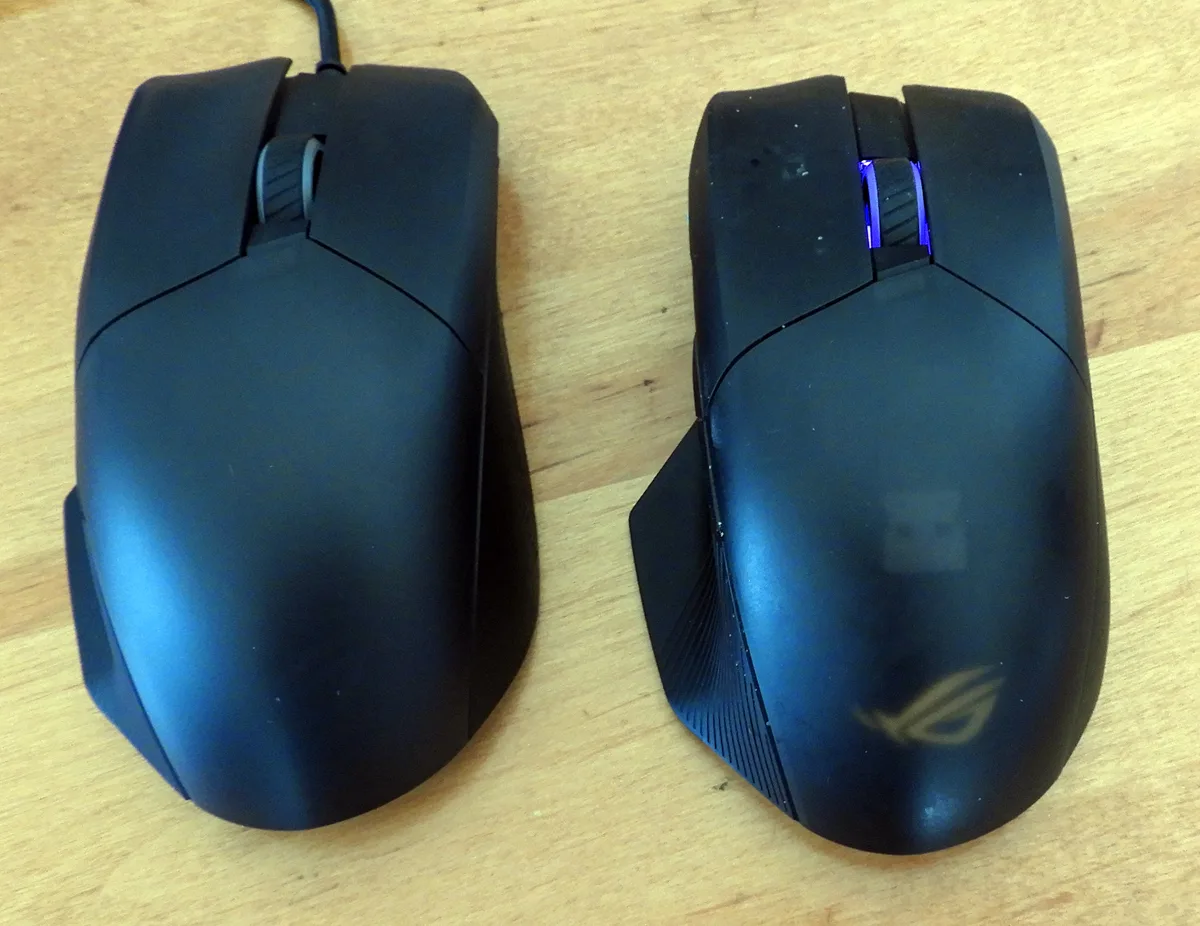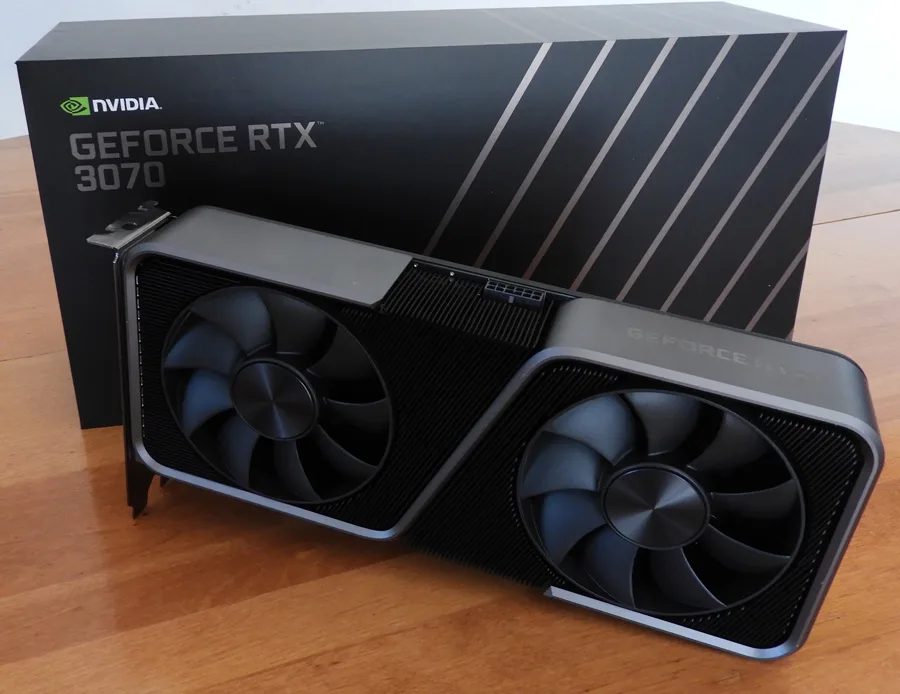The RTX 3070 Founders Edition Arrives at $499 – Performance Revealed – 35 Games, SPEC, Workstation, and GPGPU Benchmarked
BTR received the RTX 3070 8GB Founders Edition (FE) from NVIDIA and we have been testing its performance by benchmarking 35 games, and also by overclocking it. NVIDIA claims that at $499 it is as fast as the Turing Flagship, the RTX 2080 Ti, which launched at $999 to $1,199 so we compared their performance. In addition, although the RTX 3070 is a gaming GeForce card, we have added workstation, SPEC, and GPGPU benches.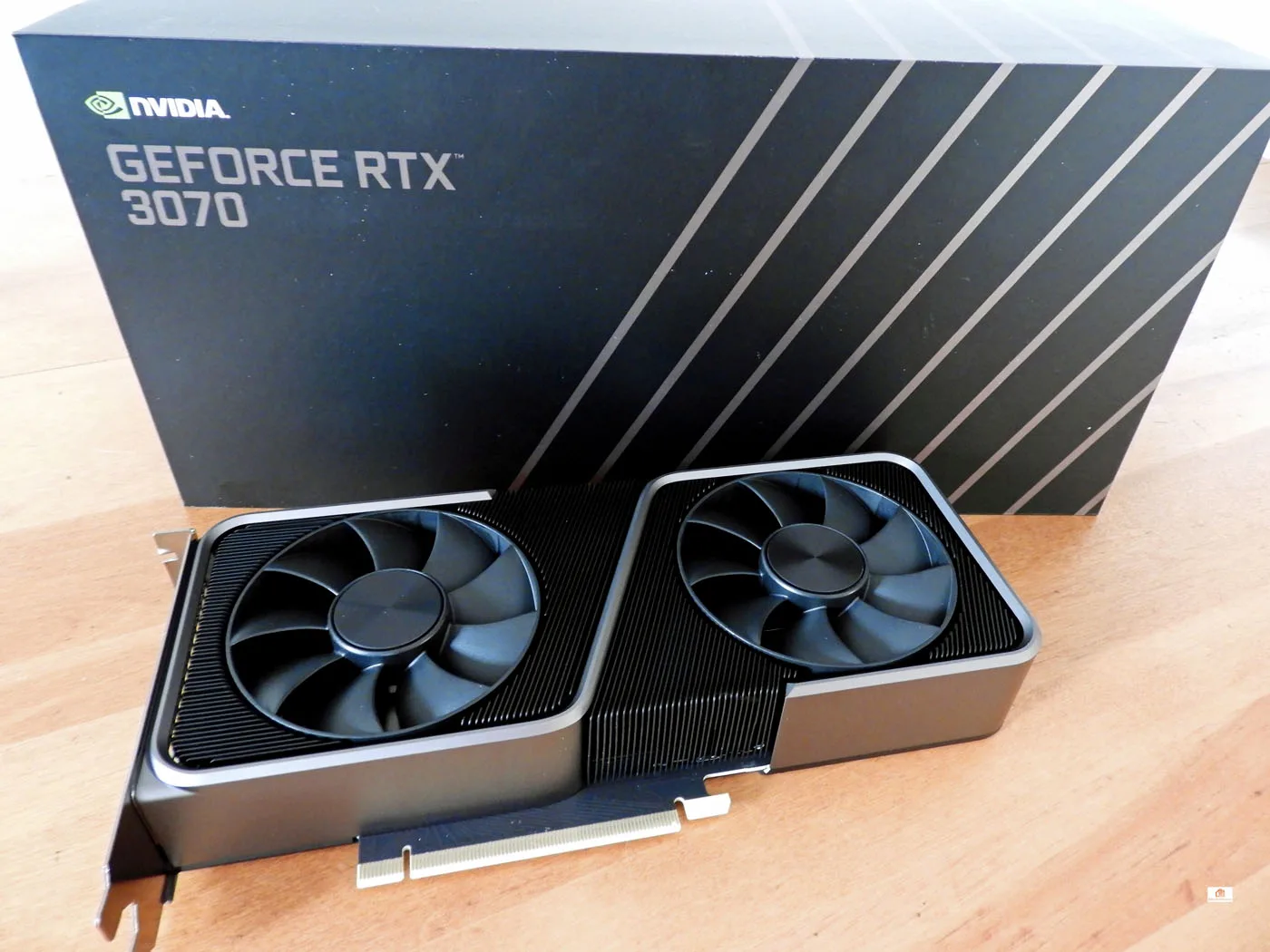
We have already covered Ampere’s features in depth and we have already reviewed the RTX 3080, the 3070’s $699 faster brother that comes equipped with 10GB of vRAM. This review will consider whether the new RTX 3070 FE at $499 delivers a good value as a compelling upgrade from the Pascal GTX 1080 Ti or even from the Ampere RTX 2070 SUPER, the refresh of the RTX 2070 FE which launched at $699 two years ago.
The RTX 3070 is not based on the GA102 chip like the RTX 3080 and the RTX 3090, but rather it uses a separate smaller GA104 GPU chip. Below is the full-chip diagram.
The RTX 3070 FE uses 64 SMs, 5888 CUDA cores, 184 3rd Generation Tensor and 46 RT cores, along with 184 Texture Units and 96 ROPs. The Boost Clock is 7000MHz, and 8192MB of GDDR6 on a 256-bit memory bus provide 448GB/s bandwidth, all within a 220W total GPU power envelope.
Since we have overclocked the RTX 3070, we will compare its overclocked performance versus stock. We have added Crysis Remastered to our benching suite to see “Can it Run Crysis” at 1080P, 1440P, and at 4K. In addition, we will also post SPECworkstation3 GPU results and a brand new version of the improved SPECviewperf 2020 benchmark which released on October 15.
Besides comparing the RTX 3070 FE’s performance with the RTX 2080 Ti FE, BTR’s test bed includes the fastest Ampere cards – the RTX 3080 FE and the RTX 3090 FE – and the Turing RTX 2080 and the RTX 2070 SUPER FE. We also test NVIDIA’s flagship Pascal cards, the TITAN Xp plus the GTX 1080 Ti FE. This time, we have added AMD’s fastest Navi card, the RX 5700 XT Anniversary Edition to compare its performance also.
We benchmark using Windows 10 64-bit Pro Edition at 1920×1080, 2560×1440, and at 3840×2160 using Intel’s Core i9-10900K at 5.1/5.0 GHz and 32GB of T-FORCE DARK Z 3600MHz DDR4 on a EVGA Z490 FTW motherboard. All games and benchmarks use the latest versions, and we use recent GeForce Game Ready drivers for games.
Let’s first unbox the RTX 3070 Founders Edition before we look at our test configuration
The RTX 3070 Founders Edition Unboxing
The Ampere generation RTX 3070 Founders Edition is a completely redesigned Founders Edition and here is the card, unboxed.
Just like with the RTX 3080 and RTX 3090 Founders Editions, the RTX 3070 comes in a “shoebox” style where the card inside lays flat at a slight incline for display. However, the RTX 3070 box is much smaller and shorter than either of its siblings. The thick padding of the box protects the card.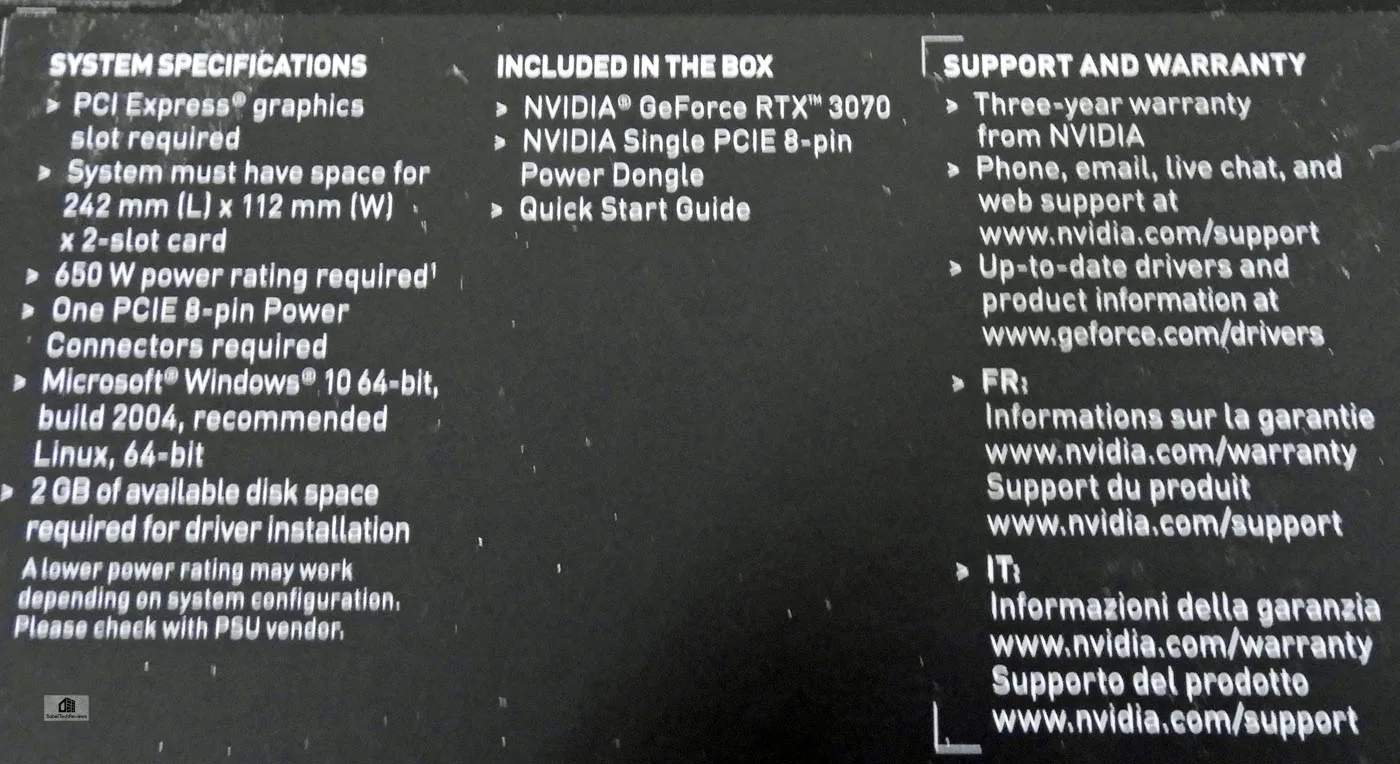
The system requirements, contents, and warranty information are printed on the bottom of each box. The RTX 3070 requires a 650W power supply unit, and the case must have space for a 242mm (L) x 112mm (W) two-slot card. It easily fits in our Phanteks Eclipse P400 ATX mid-tower.
Inside the box and beneath the card are warnings, a quick start guide and warranty information, plus the 12-pin to PCIe 8-pin dongle that will be required to connect the RTX 3070 to most PSUs.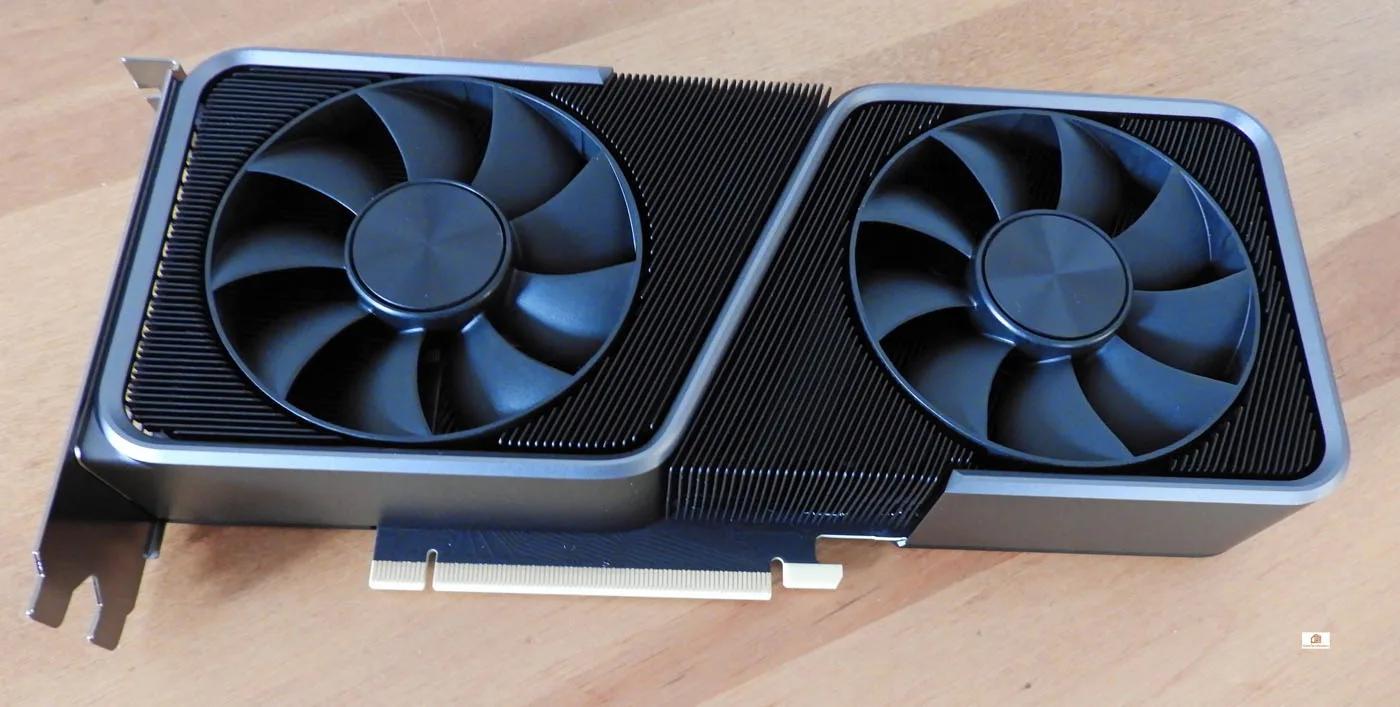
A completely redesigned shroud creates a new look for the RTX 3070 Founders Edition to provides a premium and solid heavy feel to its industrial design. It is a moderately heavy 2-slot card with dual fans.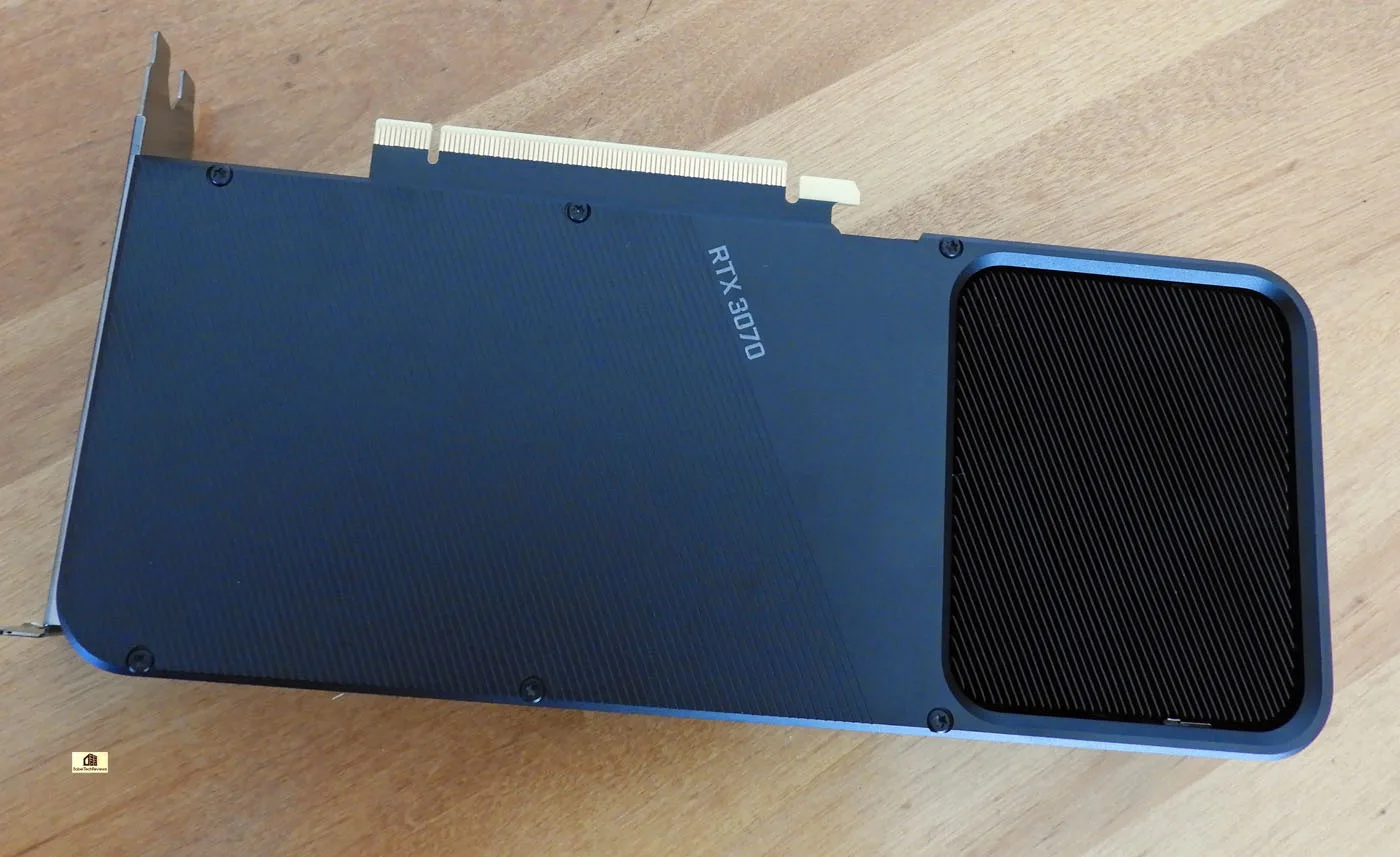
Turning the card over, we see a similar unique design of Ampere FEs. This card is designed to keep the GPU cool including by using a short PCB, and inside the card is mostly all heatsink fins.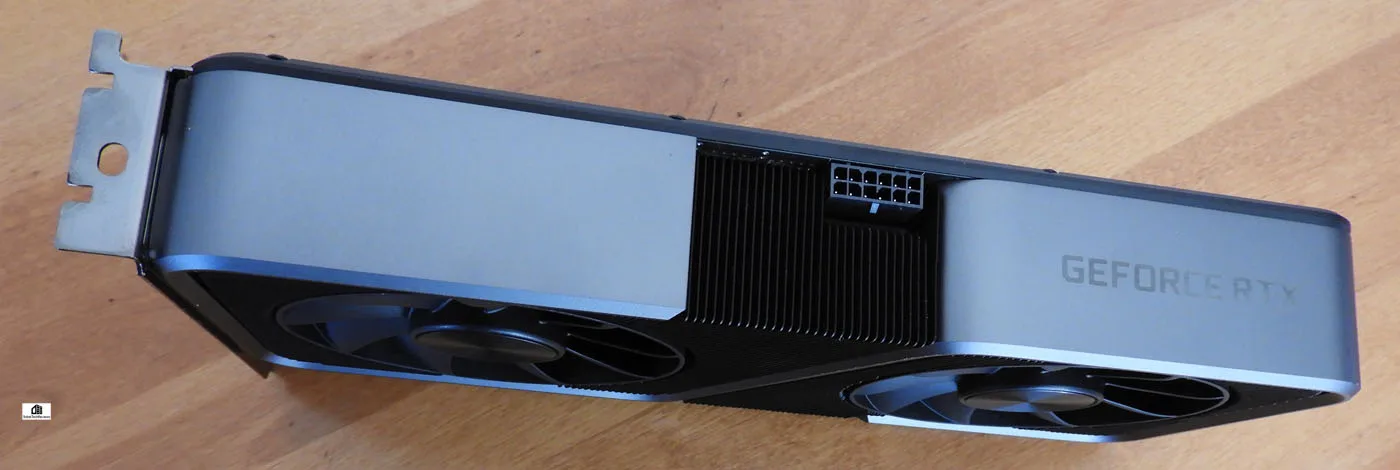

There is very large surface area for cooling so the heat is readily transferred to the fin stack and the dual fans exhaust the heat out of the back of the case and also from the top of the card into the case’s airflow.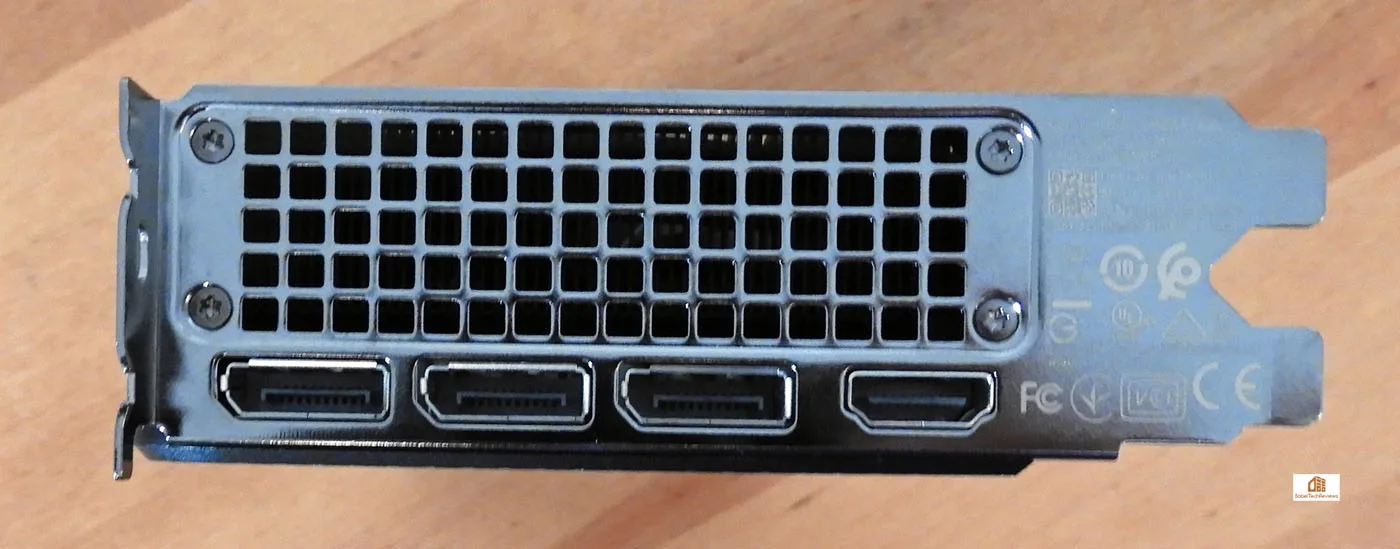
The IO panel has a very large air vent and four connectors. The connectors are similar to the Founders Edition of the RTX 2080 Ti and the RTX 3080, but the VirtualLink connector for VR is no longer offered since HMD manufacturers are not using it. Three DisplayPort 1.4 connectors are included, and the HDMI port has been upgraded from 2.0 to 2.1 allowing for 4K/120Hz over a single HDMI cable.
In our opinion, the RTX 3070 Founders Edition is a good-looking card with a unique industrial style and it looks good in any case. The logo does not light up unfortunately.
Before we look at overclocking, power and noise, let’s check out our test configuration.
Test Configuration
Test Configuration – Hardware
- Intel Core i9-10900K (HyperThreading/Turbo boost On; All cores overclocked to 5.1GHz/5.0Ghz. Comet Lake DX11 CPU graphics)
- EVGA Z490 FTW motherboard (Intel Z490 chipset, v1.3 BIOS, PCIe 3.0/3.1/3.2 specification, CrossFire/SLI 8x+8x), supplied by EVGA
- T-FORCE DARK Z 32GB DDR4 (2x16GB, dual channel at 3600MHz), supplied by Team Group
- RTX 3070 Founders Edition 8GB, stock and overclocked, on loan from NVIDIA
- RTX 3090 Founders Edition 24GB, stock clocks, on loan from NVIDIA
- RTX 3080 Founders Edition 10GB, stock clocks, on loan from NVIDIA
- RTX 2080 Ti Founders Edition 11GB, stock clocks, on loan from NVIDIA
- RTX 2080 SUPER Founders Edition 8GB, stock clocks, on loan from NVIDIA
- RTX 2070 Ti Founders Edition 8GB, stock clocks, on loan from NVIDIA
- TITAN Xp Star Wars Collectors Edition 12GB, stock clocks, on loan from NVIDIA
- GTX 1080 Ti Founders Edition 11GB, stock clocks, on loan from NVIDIA
- Radeon RX 5700 XT 8GB Anniversary Edition, stock AE clocks.
- 1TB Team Group MP33 NVMe2 PCIe SSD for C: drive
- 1.92TB San Disk enterprise class SATA III SSD (storage)
- 2TB Micron 1100 SATA III SSD (storage)
- 1TB Team Group GX2 SATA III SSD (storage)
- 500GB T-FORCE Vulcan SSD (storage), supplied by Team Group
- ANTEC HCG1000 Extreme, 1000W gold power supply unit
- BenQ EW3270U 32″ 4K HDR 60Hz FreeSync monitor
- Samsung G7 Odyssey (LC27G75TQSNXZA) 27? 2560×1440/240Hz/1ms/G-SYNC/HDR600 monitor
- DEEPCOOL Castle 360EX AIO 360mm liquid CPU cooler
- Phanteks Eclipse P400 ATX mid-tower (plus 1 Noctua 140mm fan) – All benchmarking and overclocking performed with the case closed
Test Configuration – Software
- GeForce 456.96 for the RTX 3070, the RTX 2080 Ti, and the RTX 2070 SUPER; and GeForce 456.16 Press drivers and GeForce 456.38 public drivers (functionally identical) are used for the other GeForce cards.
- Adrenalin 2020 Edition 20.10.1 drivers used for the RX 5700 XT Anniversary Edition (AE) at AE clocks.
- High Quality, prefer maximum performance, single display, set in the NVIDIA control panel.
- VSync is off in the control panel and disabled for each game
- AA enabled as noted in games; all in-game settings are specified with 16xAF always applied
- Highest quality sound (stereo) used in all games
- All games have been patched to their latest versions
- Gaming results show average frame rates in bold including minimum frame rates shown on the chart next to the averages in a smaller italics font where higher is better. Games benched with OCAT show average framerates but the minimums are expressed by frametimes (99th-percentile) in ms where lower numbers are better.
- Windows 10 64-bit Pro edition; latest updates v2004. DX11 titles are run under the DX11 render path. DX12 titles are generally run under DX12, and multiple games use the Vulkan API.
- Latest DirectX
- MSI’s Afterburner, 4.6.3 beta to set the RTX 3070’s power and temperature limits to their maximums
Games
Vulkan
- DOOM Eternal
- Red Dead Redemption 2
- Ghost Recon: Breakpoint
- Wolfenstein Youngblood
- World War Z
- Strange Brigade
- Rainbow 6 Siege
DX12
- Horizon Zero Dawn
- Death Stranding
- F1 2020
- Mech Warrior 5: Mercenaries
- Call of Duty Modern Warfare
- Gears 5
- Control
- Anno 1800
- Tom Clancy’s The Division 2
- Metro Exodus
- Civilization VI – Gathering Storm Expansion
- Battlefield V
- Shadow of the Tomb Raider
- Project CARS 2
- Forza 7
DX11
- Crysis Remastered
- A Total War Saga: Troy
- Star Wars: Jedi Fallen Order
- The Outer Worlds
- Destiny 2 Shadowkeep
- Borderlands 3
- Total War: Three Kingdoms
- Far Cry New Dawn
- Assassin’s Creed Odyssey
- Monster Hunter: World
- Overwatch
- Grand Theft Auto V
Additional Games
- RTX Quake II
- Bright Memory Infinite RTX Demo
Synthetic
- TimeSpy (DX12)
- 3DMark FireStrike – Ultra & Extreme
- Superposition
- Heaven 4.0 benchmark
- AIDA64 GPGPU benchmarks
- Blender 2.90 benchmark
- Sandra 2020 GPGPU Benchmarks
- SPECworkstation3
- SPECviewperf 2020
- Octane benchmark
NVIDIA Control Panel settings
Here are the NVIDIA Control Panel settings.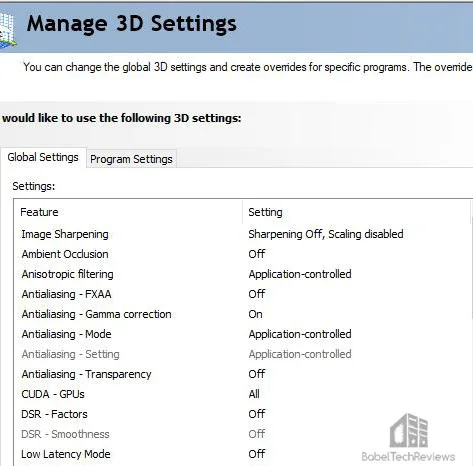


We used MSI’s Afterburner to set all video cards’ power and temperature limits to maximum as well as for overclocking and to increase the RTX 3070’s voltage to its maximum for additional overclocking.
AMD Adrenalin Control Center Settings
All AMD settings are set so that all optimizations are off, Vsync is forced off, Texture filtering is set to High, and Tessellation uses application settings. Navi cards are quite capable of high Tessellation unlike earlier generations of Radeons.

Anisotropic Filtering is disabled by default but we always use 16X for all game benchmarks.
By setting the Power Limits and Temperature limits to maximum for each card, they do not throttle, but they can each reach and maintain their individual maximum clocks. This is particularly beneficial for high power cards.
Let’s check out overclocking, temperatures and noise next.
Overclocking, Temperatures & Noise
All of our performance and overclocked testing are performed in a closed Phanteks Eclipse P400 ATX mid-tower case. Inside, the RTX 3070 is a very quiet card even when overclocked and we never needed to increase its fan speeds manually or change the stock fan profile. Compared with the RTX 2080 Ti which becomes rather loud when it ramps up, the RTX 3070 is much quieter and can barely be heard over the other fans in our PC. We overclocked the RTX 3070 using Afterburner including adding .1mV more voltage.
We used Heaven 4.0 running in a window at completely maxed-out settings at a windowed 2560×1440 to load the GPU to 98% so we could observe the running characteristics of the RTX 3070 and also to be able to instantly compare our changed clock settings with their results. At completely stock settings with the GPU under full load, the RTX 3070 ran cool and stayed below 75C with clocks that averaged around 1900MHz.
Simply raising the Power and Temperatures to their maximums resulted in the clocks running at 1920MHz to1935MHz with no changes in temperatures whatsoever using the stock fan profile. In fact, we never needed to adjust the fan profile since the GPU never rose above 75C. It never became noisy as the fan never rose above 57%. Adding .1mV to the core didn’t make any difference to stability or to performance.
Our RTX 3070’s vRAM can overclock to 8250MHz using a +1250MHz offset with a decent performance increase, but a core overclock delivers even more significant performance. The maximum stable Heaven overclock allowed us to add +1200MHz offset to the memory and +115MHz to the core, but it was not stable in games.
Our final RTX 3070 overclock turned out to be an “either – or” scenario regarding the memory OC vs the core OC. After testing multiple combinations, our RTX 3070’s final stable overclock to achieve the highest overall performance added +100MHz offset to the core and +100 MHz to the memory as pictured above which settled in above 2000MHz. The RTX 3070 FE is power-limited, and to achieve a higher overclock will take more voltage than what + .1mV can deliver. If you want a higher overclock, pick a partner overclocked AIB.
To see the performance increase from overclocking, we tested only 7 games at all three of our regular resolutions. We live in Southern California and our power company cut the power off yesterday as we were benchmarking – so we had to cut our overclocking results short. The results are given after the main performance charts in the next section.
First, let’s check out performance on the next page.
Performance Summary Charts & Graphs
Gaming Performance Summary Charts
Here are the summary charts of 34 games and 3 synthetic tests. The highest settings were always chosen and the settings are listed on the chart. The benches were run at 1920×1080, 2560×1440 and at 3840×2160. Eight cards were compared and they are listed in order starting with the least two powerful cards on the left to the most powerful on the right: the RX 5700 XT, the GTX 1080 Ti, the RTX 2070 SUPER, the RTX 2080 SUPER, the RTX 3070, the RTX 2080 Ti, the RTX 3080, and the RTX 3090.
Most results, except for synthetic scores, show average framerates, and higher is better. Minimum framerates are next to the averages in italics and in a slightly smaller font. Games benched with OCAT show average framerates, but the minimums are expressed by frametimes (99th-percentile) in ms where lower are better. An “X” means the benchmark was not run (or could not be run).
All of the games that we tested ran well except for A Total War Saga: Troy, and we suspect that it still may be a game or driver issue that has not yet been addressed by NVIDIA’s driver team. Control also had issues with setting the render resolution for 2560×1440 for some cards, and the RX 5700 XT refused to run in DX12 at all. The Shadow of the Tomb Raider benchmark refused to run on the GTX 1080 Ti and the RX 5700 XT, and it would crash to desktop when we attempted to access the benchmark. We note that cards with less than 11GB of vRAM cannot run Ghost Recon: Breakpoint at 4K/Ultimate above a slideshow.
Although there is some variability depending on which games were tested, the RTX 3070 FE generally trades blows with the slightly faster RTX 2080 Ti FE. NVIDIA claims that the RTX 3070 and the RTX 2080 Ti have similar performance, but no doubt they are referring to the entry-level non-overclocked Ti cards – the RTX 2080 Ti Founders Edition (FE) is an overclocked card.
Next we look at ten RTX/DLSS enabled games, each using maximum ray traced settings and the highest quality DLSS where available.
RTX/DLSS Benchmarks
The RTX 3070 is next compared with the same cards when ray tracing or RTX/DLSS are enabled. The RX 5700 XT can only run one ray traced non-RTX game – Crysis Remastered – so we did not include it. However, we included the GTX 1080 Ti results even though it cannot run RTX features above a crawl above 1080P in a very few selected games. We also added RTX Quake II, a fully path-traced game, and the ‘Bright Memory Infinite’ RTX demo benchmark.
The RTX 3070 now appears to be slightly faster than the RTX 2080 Ti when DLSS or RTX features are enabled. NVIDIA is expecting quite a few RTX-enabled games this year and next year, and Watch Dogs: Legion launches in two days with RTX features.
Next we look at overclocked performance.
Overclocked benchmarks
These benchmarks are run with the RTX 3070 overclocked +100MHz on the core and +100MHz on the memory versus at stock clocks. The RTX 3070 stock results are presented first and the overclocked RTX 3070 is in the second column.
There is a small performance increase from overclocking the RTX 3070. NVIDIA has evidently locked Ampere cards overclocking down in an attempt to maximize performance for all Founders Edition gamers. We would also suggest that the RTX 3070 is rather voltage constrained and if you want a higher overclock, pick a factory-overclocked partner version instead of a Founders Edition.
Let’s look at non-gaming applications next to see if the RTX 3070 is a good upgrade from the other video cards we test starting with Blender.
Blender 2.90 Benchmark
Blender is a very popular open source 3D content creation suite. It supports every aspect of 3D development with a complete range of tools for professional 3D creation.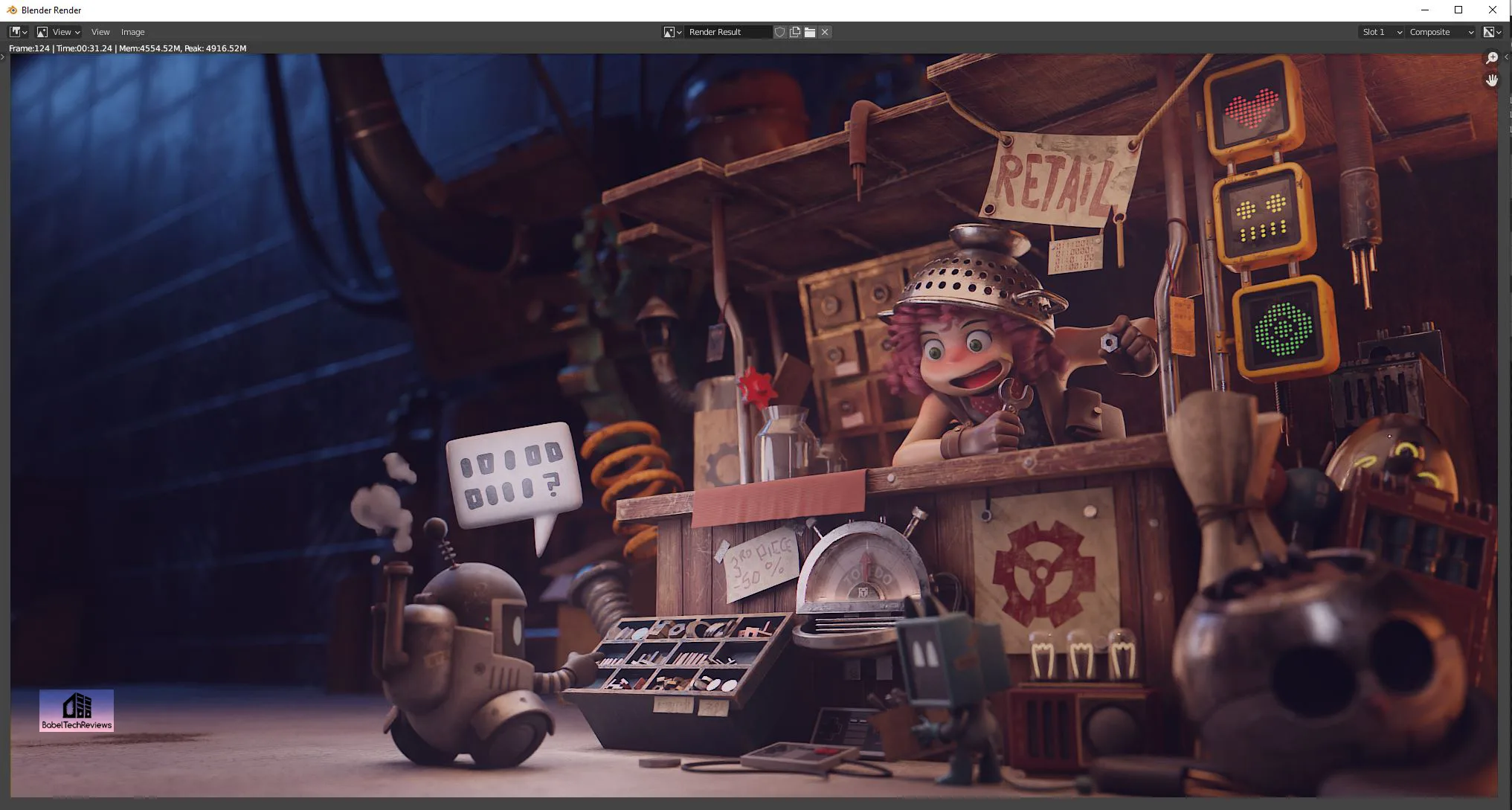
We benchmarked three Blender 2.90 benchmarks which measure GPU performance by timing how long it takes to render production files. We tested seven of our comparison cards with both CUDA and Optix running on the GPU instead of using the CPU. We did not benchmark the RX 5700 XT using OpenCL.
For the following chart, lower is better as the benchmark renders a scene multiple times and gives the results in minutes and seconds.
Blender’s benchmark performance is similar using the RTX 3070 compared with the RTX 2080 Ti.
Next we look at the OctaneBench.
Octane Bench
OctaneBench allows you to benchmark your GPU using OctaneRender. The hardware and software requirements to run OctaneBench are the same as for OctaneRender Standalone.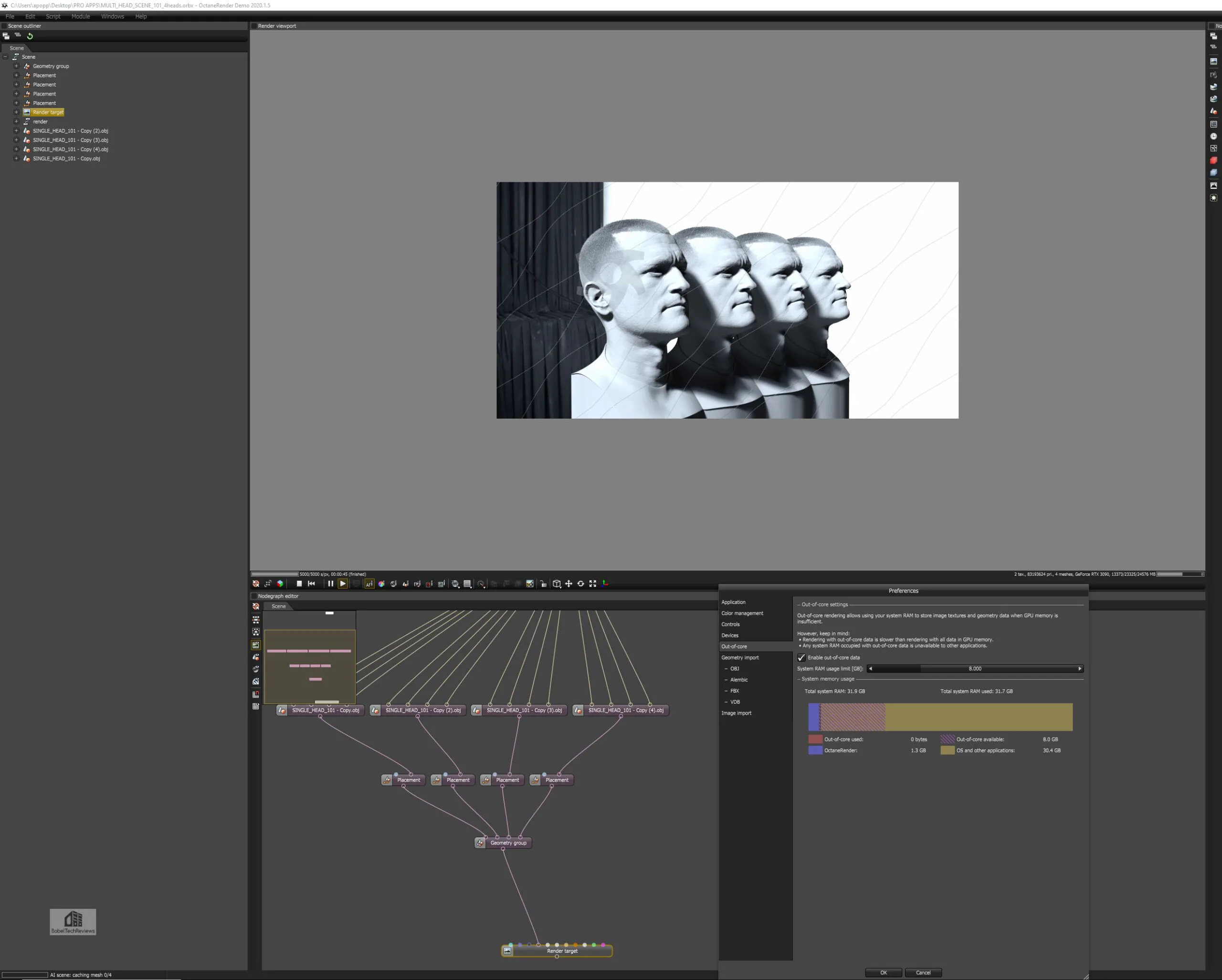
We run OctaneBench 2020.1.5 for Windows and here are the RTX 3070’s complete results and overall score of 411.73.
We compare with the score and results for the RTX 2080 Ti with 384.24.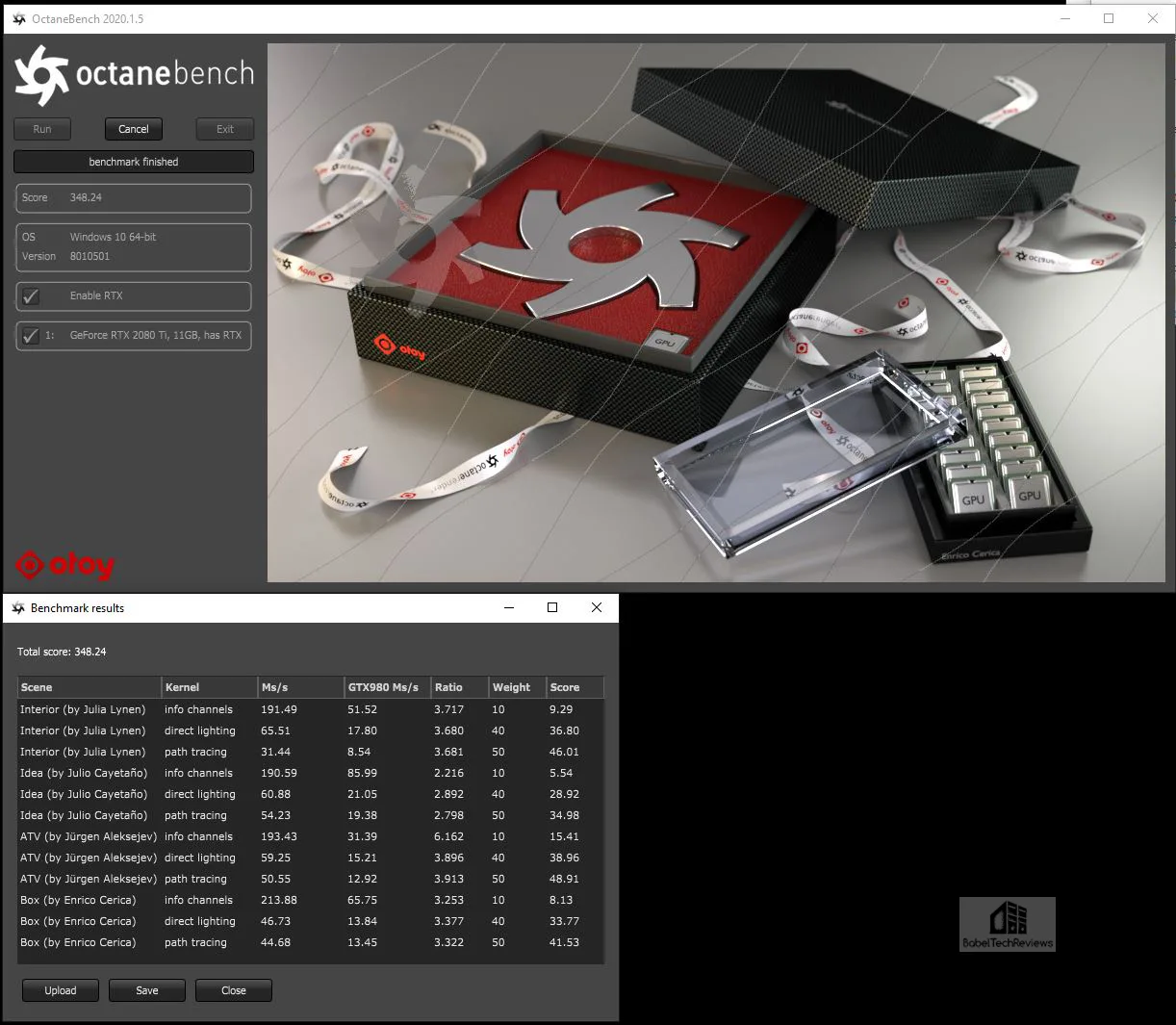
Here is the summary chart comparing the TITAN Xp, the RTX 2070 SUPER, the RTX 2080 Ti, the RTX 3070, the RTX 3080, and the RTX 3090.
The RTX 3070 is a very decent card when used for rendering.
Next, we move on to AIDA64 GPGPU benchmarks.
AIDA64 v6.25
AIDA64 is an important industry tool for benchmarkers. Its GPGPU benchmarks measure performance and give scores to compare against other popular video cards.
AIDA64’s benchmark code methods are written in Assembly language, and they are well-optimized for every popular AMD, Intel, NVIDIA and VIA processor by utilizing the appropriate instruction set extensions. We use the Engineer’s full version of AIDA64 courtesy of FinalWire. AIDA64 is free to to try and use for 30 days. CPU results are also shown for comparison with both the RTX 3070 and GTX 2080 Ti GPGPU benchmarks.
Here are the RTX 3070 AIDA64 GPGPU results compared with an overclocked i9-10900K.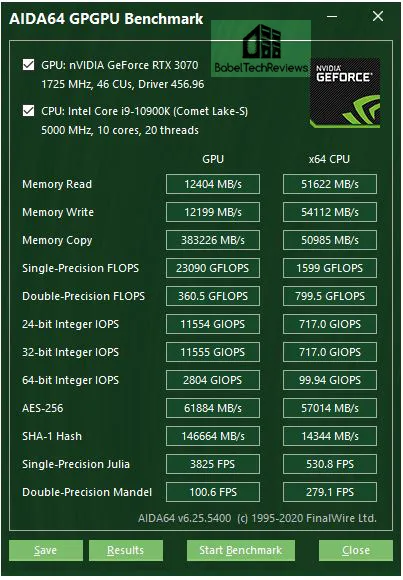
Here is the chart summary of the AIDA64 GPGPU benchmarks with seven of our competing cards side-by-side.
The RTX 3070 is a fast GPGPU card and it compares favorably with the RTX 2080 Ti. So let’s look at Sandra 2020 next.
SiSoft Sandra 2020
To see where the CPU, GPU, and motherboard performance results differ, there is no better tool than SiSoft’s Sandra 2020. SiSoftware SANDRA (the System ANalyser, Diagnostic and Reporting Assistant) is a excellent information & diagnostic utility in a complete package. It is able to provide all the information about your hardware, software, and other devices for diagnosis and for benchmarking. Sandra is derived from a Greek name that implies “defender” or “helper”.
There are several versions of Sandra, including a free version of Sandra Lite that anyone can download and use. Sandra 2020 R10 is the latest version, and we are using the full engineer suite courtesy of SiSoft. Sandra 2020 features continuous multiple monthly incremental improvements over earlier versions of Sandra. It will benchmark and analyze all of the important PC subsystems and even rank your PC while giving recommendations for improvement.
The author of Sandra 2020 informed us that while NVIDIA has sent some optimizations, they are generic for all cards, not Ampere specific. The tensors for FP64 & TF32 have not been enabled in Sandra 2020 so GEMM & convolution running on tensors will get faster using Ampere’s tensor cores. BF16 is supposed to be faster than FP16/half-float, but since precision losses are unknown it has not yet been enabled either. And finally, once the updated CUDA SDK for Ampere gets publicly released, Sandra GPGPU performance should improve also.
With the above in mind, we ran Sandra’s intensive GPGPU benchmarks and charted the results summarizing them.
In Sandra GPGPU benchmarks, the RTX 3070 is similar in performance to the RTX 2080 Ti. However, since the architectures are different, each card exhibits different characteristics with different strengths and weaknesses.
SPECworkstation3 (3.0.4) Benchmarks
All the SPECworkstation3 benchmarks are based on professional applications, most of which are in the CAD/CAM or media and entertainment fields. All of these benchmarks are free except for vendors of computer-related products and/or services.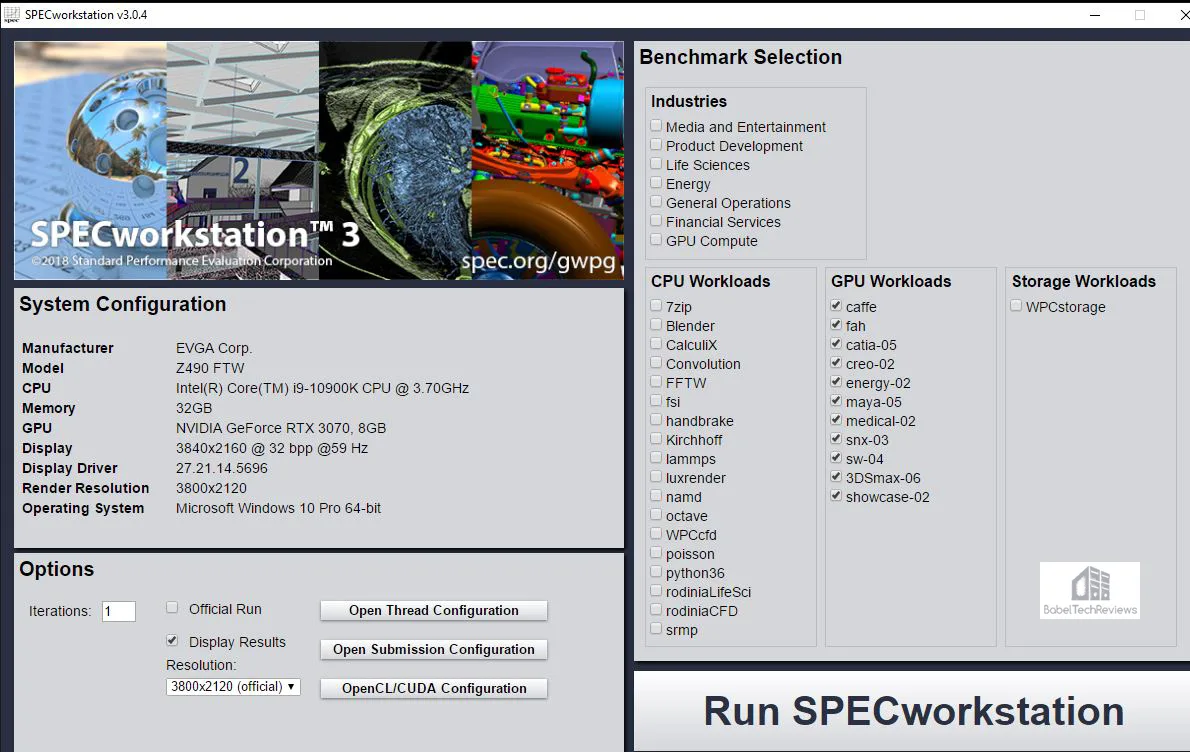
The most comprehensive workstation benchmark is SPECworkstation3. It’s a free-standing benchmark which does not require ancillary software. It measures GPU, CPU, storage and all other major aspects of workstation performance based on actual applications and representative workloads. We only tested the GPU-related workstation performance as checked in the image above.
Here are our raw SPECworkstation 3.0.4.summary and raw scores for the RTX 3070.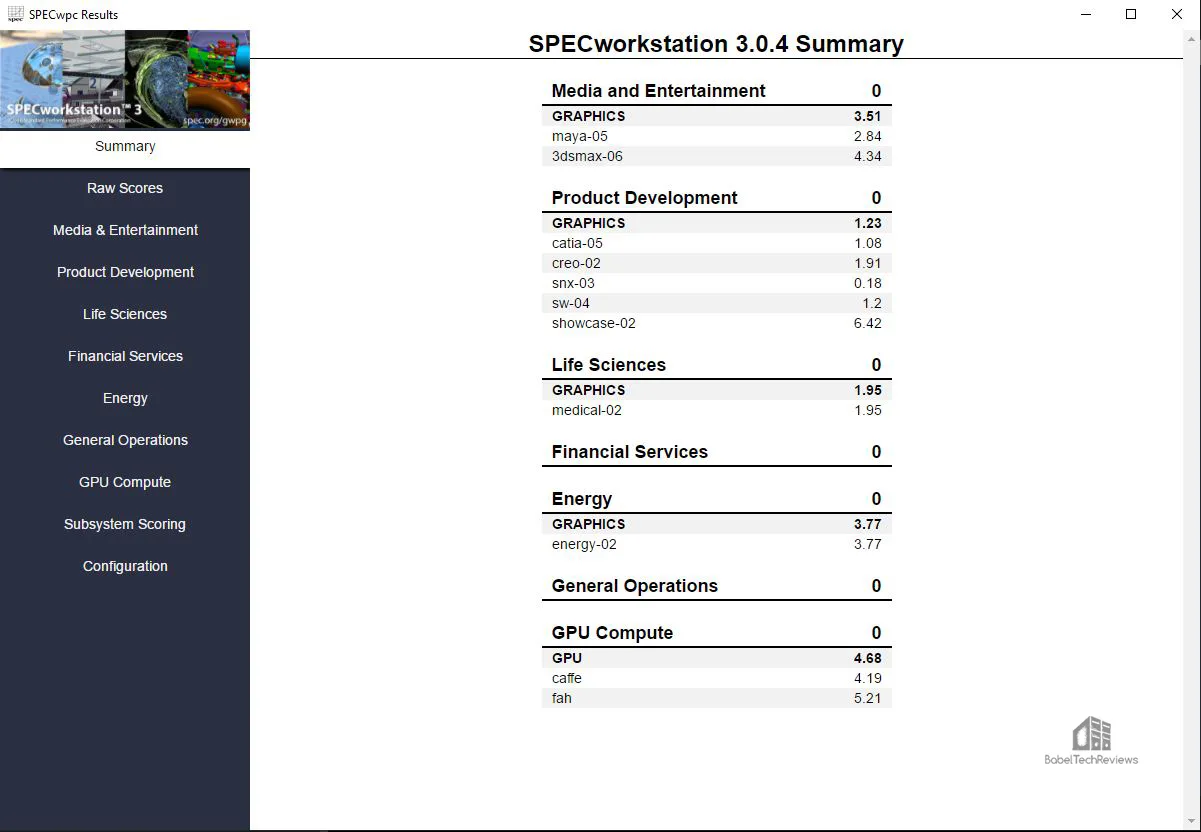
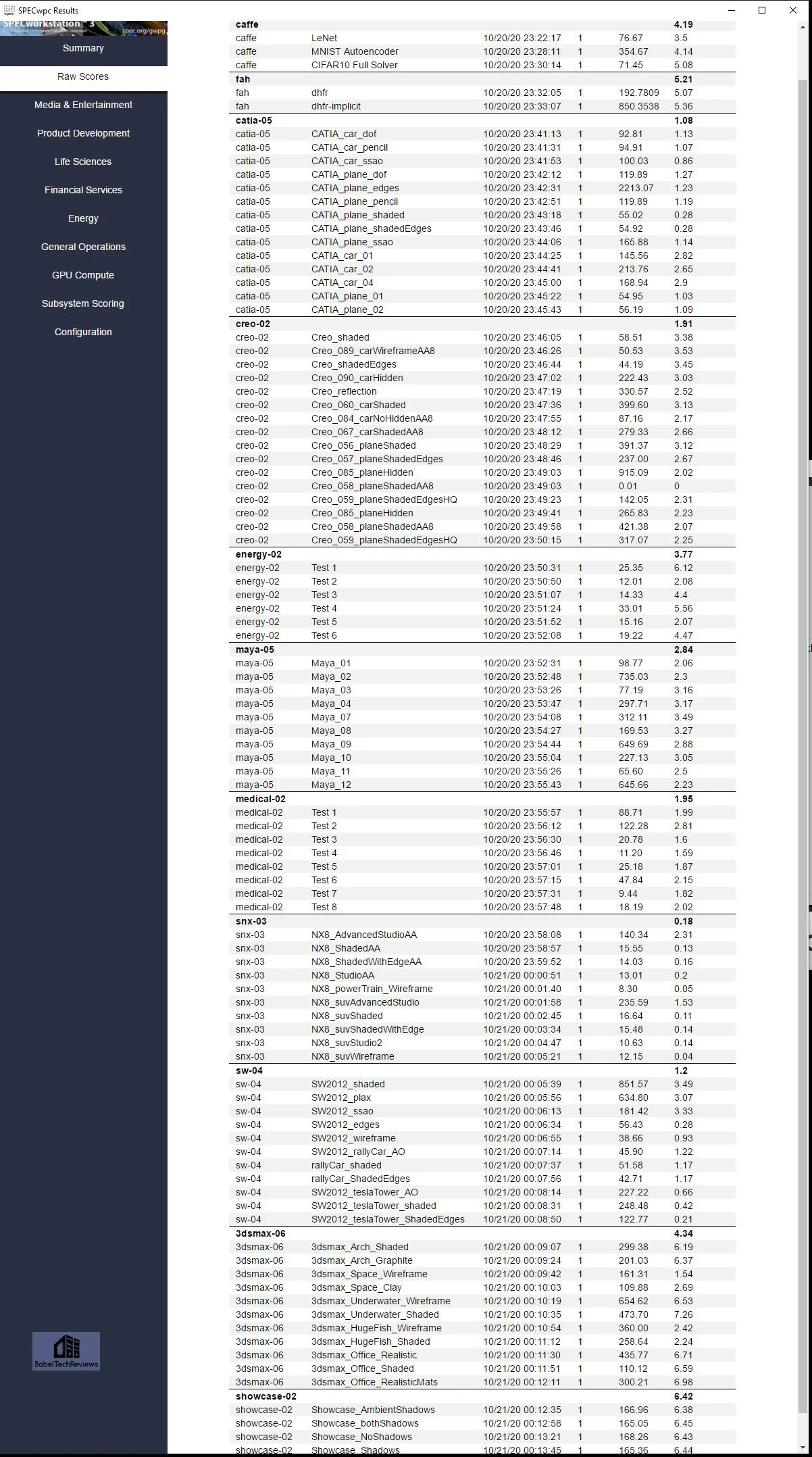
Here are the SPECworkstation3 results summarized in a chart along with six competing cards. Higher is better.
Using SPEC benchmarks, the RTX 3070 is similar in performance to the RTX 2080 Ti. However, since the architectures are different, the cards each exhibit different characteristics with different strengths and weaknesses.
SPECviewperf 2020 GPU Benches
The SPEC Graphics Performance Characterization Group (SPECgpc) has released a new 2020 version of its SPECviewperf benchmark twelve days ago that features updated viewsets, new models, support for both 2K and 4K display resolutions, and improved set-up and results management.
We benchmarked at 4K and here are the summary and the raw results for the RTX 3070.
Here are SPECviewperf 2020 GPU benchmarks summarized in a chart together with the three other cards that we had time to test, the RTX 2080 Ti, the RTX 2070 SUPER and the RX 5700 XT.
The RTX 2080 Ti appears to be a little faster than the RTX 3070 in SPECviewperf 2020 GPU benches, but both cards are generally faster than the RX 5700 XT or the RTX 2070 SUPER.
After seeing these benches, some creative users will probably upgrade their existing systems with a new RTX 30X0 series card based on the performance increases and the associated increases in productivity that they require. The question to buy an RTX 3070 should be based on the workflow and requirements of each user as well as their budget. Time is money depending on how these apps are used. However, the target demographic for the RTX 3070 is primarily gaming for gamers, especially at 1440P.
Let’s head to our conclusion.
Final Thoughts
This has been a very enjoyable experience evaluating the new Ampere RTX 3070 versus the seven other cards we tested. The $499 RTX 3070 FE performed very well performance-wise compared to the RTX 2080 Ti FE – formerly the fastest gaming card in the world that released at $1199. The RTX 3070 at $499 is a solid upgrade from the GTX 1080 Ti that originally launched at $699 even though we were originally hesitant to recommend the upgrade to a RTX 2080 Ti two years ago based on its value to performance.
If a gaming enthusiast wants a very fast card that matches the RTX 2080 Ti FE that released just in the past two years, then it is an excellent card for 1440P gaming – and even at 4K with some settings lowered. Unfortunately, we only were able to spend 85 hours with the RTX 3070 and we had to focus on performance, and we simply did not have time to touch on its other features including Reflex and Broadcast. 
We plan to follow up with a Reflex Analyzer kit review which features the ASUS ROG Swift 360Hz G-SYNC Gaming Monitor PG259QNR and the ASUS ROG Chakram Core Gaming Mouse. We will compare our Samsung G7 Odyssey 27? 2560×1440/240Hz/1ms/G-SYNC/HDR600 monitor with the new 360Hz/1ms ROG Swift 24″ display, and we now have two Chakram gaming mice (the wired mouse is part of the Reflex Analyzer kit) which have become our go-to gaming mice because of their incredible response and feel. No more Logitech for us!
We are very impressed with the Founders Edition of the RTX 3070 after spending nearly 90 hours testing it over the past 6 days. It offers exceptional performance at 1440P and and it even supports playable gaming at 4K. For $499, the Founders Edition of the RTX 3070 is well-built, solid, and good-looking, and it stays cool and quiet even when overclocked. The RTX 3070 Founders Edition offers a solid value for GTX 1080 Ti or even for RTX 2070 SUPER owners. Gamers using lower performance cards will love the new $499 Ampere card.
Pros
- The RTX 3070 at $499 is the near-equal of the RTX 2080 Ti which launched at $999 to $1,199 and it is a jump in performance over most older cards such as the RTX 2070 SUPER or the GTX 1080 Ti.
- The RTX 3070 is perfect for 1440P gaming at maxed out settings and even for 4K gaming with high settings; and it’s also very useful for intensive creative, SPEC, or GPGPU apps
- Ray tracing is a game changer in every way and the RTX 3070 is generally faster than the RTX 2080 Ti when DLSS 2.0 or RTX features are enabled
- Reflex and Broadcast are important features for competitive gamers and broadcasters
- Ampere improves over Turing with AI/deep learning and ray tracing to improve visuals while also increasing performance with DLSS 2.0 and Ultra Performance DLSS
- The RTX 3070 Founders Edition design cooling is quiet and efficient; the GPU in a well-ventilated case stays cool even when overclocked and it remains quiet using the stock fan profile
- The industrial design is eye-catching and it is solidly built
- Price to performance value is solid especially compared with the RTX 2080 Ti
Cons
- The RTX 3070 is voltage constrained for overclocking, and if you need a high overclock, choose an overclocked partner card.
The Verdict:
If you are a gamer who plays at maxed-out 1440P, you may do yourself a favor by upgrading to a RTX 3070. The RTX 3070 Founders Edition offers good performance value as an upgrade from a GTX 1080 Ti with the additional benefit of being able to handle ray tracing, and it can even meet the demands of 4K gaming with high settings.
The RTX 3070 Founders Edition is available starting today for $499 from NVIDIA’s online store, and USA customers can purchase these cards also directly from Best Buy and Microcenter stores, both online and in person. Canadian customers may purchase RTX 3070 Founders Edition cards from BestBuy.com.
Stay tuned, there is a lot more on the way from BTR. Next up, we will test the RTX 3070 in VR versus the RTX 2080 Ti and the GTX 1080 Ti using the Vive Pro with an ETA of early next week. Stay tuned to BTR!
Happy Gaming!
